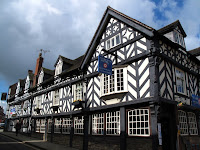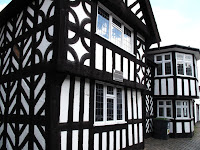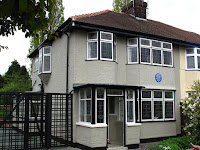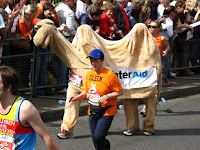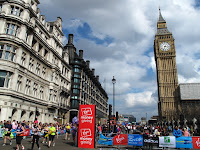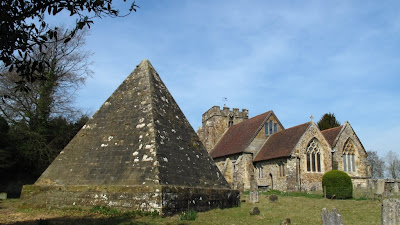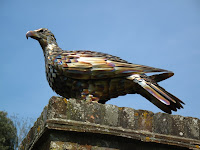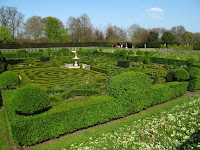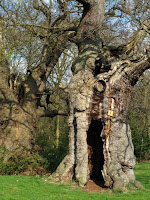

After spending the night in a suburb of North Manchester, we were perfectly placed to start the day with a look around the city. The outskirts of Manchester looked very depressed, with closed shops and boarded up buildings everywhere. The city centre seemed to have survived the recession, and we enjoyed walking around the buildings reflecting the grander styles of past eras, and modern look of glass and copper at The Lowry re-development of the docklands area.
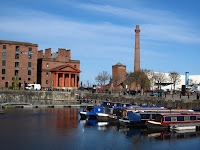
The highlight of Manchester was a visit to the John Ryland Library. The wife of this Victorian industrialist built the library, which opened in 1900, to commemorate his life. She chose a Gothic style to compete with the great libraries at Cambridge and Oxford, and the building is stunning. There is a large Reading Room, and smaller rooms filled with interesting exhibitions.


From Manchester we travelled the short distance south back to Liverpool. Once again, the outer areas looked very sad, with many closed premises, and the city centre itself is a mixture of grand, but tired buildings and livelier but equally shabby areas. A good proportion of the city centre is now a UNESCO heritage site, and we were frankly not sure why. But the heritage area of the Albert Docks, is also UNESCO, and this is a total delight to spend time in. The old dock buildings have been given a new lease of life as shops, restaurants, cafes and museums.


A 30 minute walk uphill, leads to the Metropolitan Cathedral. This Catholic church, opened in 1967, is dramatic in design both inside and out. The lantern is the largest lead light window in the world and combined with the blue leadlight windows around the circular building, fills the whole auditorium with a blue glow.

A short walk along Hope Street took us to the Philharmonic Dining Room. This equally dramatic building, originally for pre or post-show gatherings, is definitely worth a visit. The look downstairs is of an opulent Gentlemen's club, complete with the only Grade 1 listed Gents in the UK, which ladies are able to inspect if the coast is clear.

When we visited, although reasonably early in the evening, the place was already bustling with people clutching their glasses while standing in the only places available – the corridors. Upstairs is much more peaceful (and also less grand, as it was the room the carriage drivers used to wait in) and we were one of only two tables enjoying a very nice and quiet meal.
 Temperatures plummeted in the UK this week, so it seemed like a good day to check out the new Magnificent Maps exhibition at the British Library. This free exhibition is well worth visiting.
Temperatures plummeted in the UK this week, so it seemed like a good day to check out the new Magnificent Maps exhibition at the British Library. This free exhibition is well worth visiting.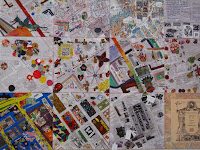 The maps on display came from many different countries, and included the World's largest Atlas, presented to Charles II in 1660. It has 41 maps, many unique and the others very rare.
The maps on display came from many different countries, and included the World's largest Atlas, presented to Charles II in 1660. It has 41 maps, many unique and the others very rare. We were fascinated to read the notes accompanying the display on how maps were used in the past, that “Rulers received their guests in their audience chamber, where maps conveyed their power and dominance.” As we have a tapestry map in our living room (purchased on holiday in Florence and supposedly a copy of Christopher Columbus's map of the world), we decided that this put us up with the 'ruler' mentality.
We were fascinated to read the notes accompanying the display on how maps were used in the past, that “Rulers received their guests in their audience chamber, where maps conveyed their power and dominance.” As we have a tapestry map in our living room (purchased on holiday in Florence and supposedly a copy of Christopher Columbus's map of the world), we decided that this put us up with the 'ruler' mentality.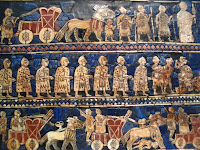 The Library also has a permanent exhibition which features among other interesting items, the original hand written lyrics for some of the Beatles' famous hits and two of the four extant copies of the Magna Carta.
The Library also has a permanent exhibition which features among other interesting items, the original hand written lyrics for some of the Beatles' famous hits and two of the four extant copies of the Magna Carta. A real treat when visiting the Library, is to have lunch right beside King George III's library collection. This was donated to the British Museum by his son George IV, and since relocated to a specially designed four story tower, appropriately called the King's Library Tower.
A real treat when visiting the Library, is to have lunch right beside King George III's library collection. This was donated to the British Museum by his son George IV, and since relocated to a specially designed four story tower, appropriately called the King's Library Tower.

 The British Museum is only a short walk away, and we enjoyed our first visit in years, to have a dip into the various galleries by way of their new 'History of the World in 100 Objects' programme. This is in conjunction with the BBC, and so far only the first 30 objects are identified, with a map to find them. It was a great way to follow a theme and cover most of the Museum in the process.
The British Museum is only a short walk away, and we enjoyed our first visit in years, to have a dip into the various galleries by way of their new 'History of the World in 100 Objects' programme. This is in conjunction with the BBC, and so far only the first 30 objects are identified, with a map to find them. It was a great way to follow a theme and cover most of the Museum in the process.















